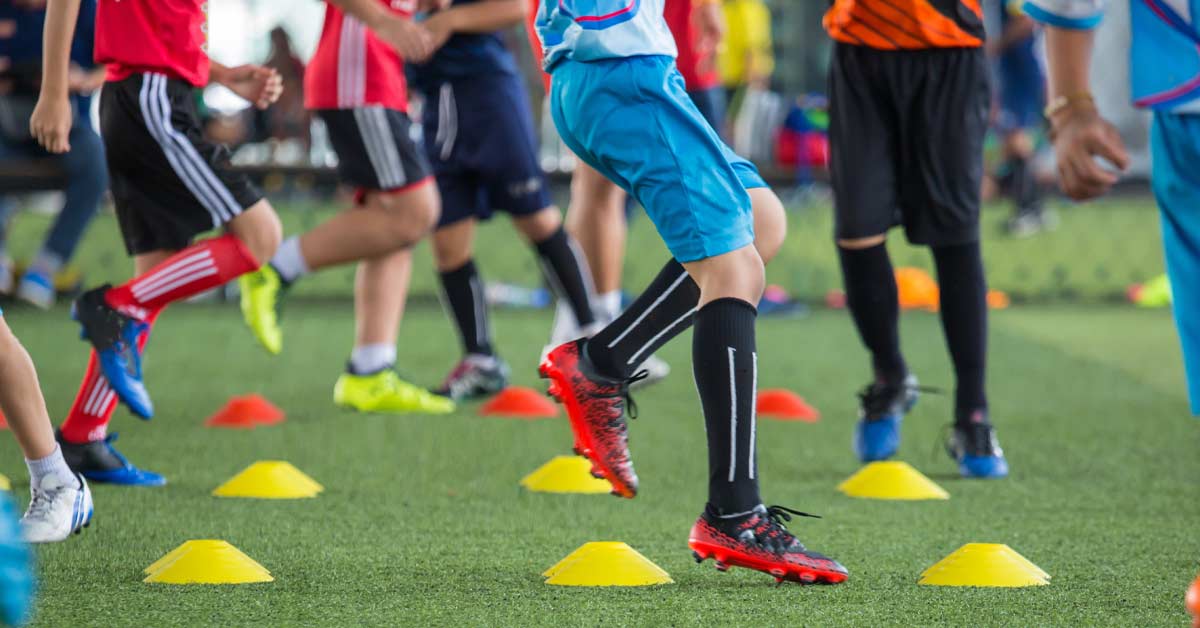[mashshare]
I felt compelled to write this article because I am scared for the future of sport. However, instead of pointing out the obvious, I decided to meet the problem head-on. A few months ago, I got a phone call from a parent asking if I could help with their son’s training, and I was horrified to discover that the kid was not even in kindergarten yet. This story is not uncommon.
My own daughter will be entering kindergarten this fall and she has yet to play an organized sport. She’s been very fortunate to have been raised in my gym around professional, collegiate, and high school athletes. My wife and I both played college sports, both work in the fitness space, and both continue to train ourselves.
We know the value of training and hard work, but we want to make sure our daughter has fun first and foremost. We try to focus our coaching on positive feedback along with encouraging effort. We hope our daughter and future children enjoy sports and competition as much as we do/did, but we aren’t going to force it. We want it to be organic.
The future of sport doesn’t look good right now, with an alarming trend of falling participation rates, rising injury rates, and more and more videos of parents acting like children. It’s out of control and many of the people in leadership positions are not doing anything about it. Not being involved in youth sport isn’t an excuse to look the other way or put your head in the sand; a small act of defiance against the “win at all costs” attitude is enough if it’s collective.
A small act of defiance against the ‘win at all costs’ attitude is enough if it’s collective, says @SPSmith11. Share on XWhile professional and college athletes have their own problems, in time, the future elites will come from youth sports. Here are ways we can make sports safer and more enjoyable for today’s youth athletes.

Teach Parents About the Recruiting Process and Being a Better Fan
Parents play an expensive lottery with scholarship hunting, and most of the time athletes who are pushed to use their athletic abilities to get into college never make it. In addition to the wild goose chase for a full ride, parents become nasty fans who lose their compass along the way. In fact, the term “fan” comes from the word “fanatic,” and the way people act at games borders on insanity nowadays.
The parents looking for kids to play sports to get a better education have good intentions, as a college degree has enormous value. But the stark reality is that a parent’s DNA has more of an impact on the child getting into school for sports than summer camp selection or choosing the right private coach.
As role models, parents in the stands should act in a way that teaches their kid that everyone in sport should be respected and valued. As guardians, they should be educated on how rare scholarships are and why they’re not for everyone, including their own child. They need to know that being both a fan of their kids and driver of their future is more than simply scholarships for college—it’s the health and well-being of their own children and, potentially, their grandchildren.
We need higher-level coaches to warn about overspecialization, and overdosing on sports in general, says @SPSmith11. Share on XWe need more outreach on general parenting in sports, and the best way to do this is to have higher-level coaches warn the public about overspecialization and overdosing on sports in general. Playing multiple sports is not the answer; it’s about having the right structure and balance, which is something not easily sold to parents who think they know more than they actually do. Parents need to just be parents, and be there to help and educate their children.
In the great article, “What Makes A Nightmare Sports Parent — And What Makes A Great One,” Steve Henson quotes a speech by Bruce E. Brown, a high school and youth coach:
“Overall, grandparents are more content than parents to simply enjoy watching the child participate,” he says. “Kids recognize that.”
A grandparent is more likely to offer a smile and a hug, say “I love watching you play,” and leave it at that.
Meanwhile a parent might blurt out …
“Why did you swing at that high pitch when we talked about laying off it?”
“Stay focused even when you are on the bench.”
“You didn’t hustle back to your position on defense.”
“You would have won if the ref would have called that obvious foul.”
“Your coach didn’t have the best team on the field when it mattered most.”
Parents are part of the problem and part of the solution, so fostering an environment where a kid can enjoy being a kid is a great start instead of chasing scholarships too early. Our goal is to make training a part of the fun athletes should have, and bring back the enjoyment they may have lost in the process.

Put a Pause on Sports and Make Games Fun and Rewarding
The first step to making better athletes is to stop competing in sports and start playing more games. In fact, the problem with youth athlete development is that the public and some coaches think youth sports is miniature professional sports, just with younger athletes. Sports usually reveal or showcase talent, while games develop everyone, not just the gifted kids. Games don’t focus on who wins—they focus on learning and having fun. When nobody loses, everyone wins, provided it’s done at the appropriate level.
The problem is that the public and some coaches think youth sports is miniature professional sports, says @SPSmith11. Share on XMost kids are typically scared to try, but when we only reward success, kids are quicker to give up when things don’t go their way. It’s extremely important for parents and coaches to encourage kids to try and practice—continuous effort and focus should be the message. Try not to only encourage the “natural” and “gifted” performances.
Be active in getting your children to participate in and try new sports. My father reminds me all the time that when my brother and I were young, we just wanted to play outside, play in the pool, and play video games. He claims that we always complained about going to practice and games, but once we got on the field, we always had fun and competed hard.
Games encourage participation because nothing is at stake except exploration and creativity. When kids are playing not to lose, experimentation and the evolution of the sport suffer because taking a risk is too risky. Another benefit to games is that they are focused on the participant having instant success and enjoyment, not being overwhelmed with rules and equipment limitations. Even free and unstructured play, like recess activities, is disappearing. It doesn’t matter if it’s at home or at school, raw play is an endangered species because kids are being poached for youth sports that generate big business.

Support Physical Education and Nutrition Programs
Everyone talks about the value of exercise and fitness for children, but when it comes down to budgeting, physical education is being either scrapped or gutted. “Gym teachers” are usually unappreciated, overworked, and poorly supported by the school system. Not many superintendents have enough moral conviction to apply the research and make changes based on what they know is true.
If you want your child to succeed, learn from Finland and get moving. The book Spark should be the backbone of the curriculum in every school district in America, but like PE teachers, it’s mentioned in workshops and then ignored when the school day gets carved up. Kids should have access to free play, guided play, and instructed play as an essential right.
I am a great example of a clumsy child who teachers took from being probably the least athletic person in the grade, to becoming a captain on a state-winning team in high school. While I give all the credit in the world to my high school coaches, the PE programs from elementary to middle school were instrumental in teaching me to move. To this day, I still use all the lessons learned from PE beyond sports coaching, as they helped me become competent in exercise and wellness. Kids now are less active and less motivated to be active, and the obesity crisis is growing. Activity is not valued, and all the Fitbits in the world will not save our population if what we are doing is not fun or rewarding.
My take on gym was it always pretty fun, and games were usually easy (basketball, floor hockey, baseball, softball, football, dodgeball, mat ball, volleyball, etc.). I actually enjoyed playing tag or capture the flag more than participating in sports. I would say capture the flag, dodgeball, and mat ball (kickball) were my favorite gym class games.
I still use lessons learned from PE, as they helped me become competent in exercise and wellness, says @SPSmith11. Share on XIn addition to the PE program, nutrition is another challenge faced by schools. Because children are a target consumer for billion-dollar companies, kids’ diets have been transformed into a junk food paradise. Kids are either hungry or overfed, and we need to overhaul the foods kids consume in order to reduce childhood obesity.
Just having a better cafeteria is not the answer, as the process of learning about nutrition can’t wait until high school biology; it must be taught early so kids understand how what they eat makes a difference. It’s embarrassing what kids in the U.S. eat compared to other countries, yet few schools are stepping up. A good solution is to have schools partner with farms and grow their own food so education and nutrition are both connected.

Reignite Town Teams and Kill Off Travel Squads
I generally hate travel teams, not because kids shouldn’t have fun exploring a new city, but because most kids are better equipped to compete locally. Most programs are designed to financially support the one star on the team by including pay-to-play athletes or drain the area’s talent and make “superteams.” We end up seeing a never-ending season that grinds down a kid into overuse injuries and mental exhaustion. It’s not right, but not only is it allowed—it’s encouraged, with a large price tag.
I tell parents all the time: “Don’t worry about your kid getting seen. If they are that good, colleges will find them.” It’s rare that a kid is so great that the talent around them is holding back their development. For every Messi going to the Academy in Barcelona, there are a million young athletes who will never play professionally. It’s not that trying is an inappropriate goal—everyone has the right to dream—but stacking the odds with more competition and travel doesn’t address the needs of development.
The real solution for youth sports is just the opposite of what is being done now with travel teams. Have the kids play different sports and practice more, so the opportunity to compete is valued by the athlete. Training is the ultimate teacher, and too many travel teams participate in tournaments to give the family a reason to tour like wannabe pro teams. Tournaments are nothing more than gasoline to a wildfire in youth sports; they place inhumane orthopedic and physiological strain on athletes who are not prepared to handle such workloads. It’s not ethical and it needs oversight by the right organization.
Town teams are not immune to over-competing, either. Staying local allows more competition to happen because travel is not a barrier, but a good safeguard is to keep games shorter and only as frequent as deemed appropriate by a collective set of transdisciplinary experts and parents. While moms and dads are sometimes the problem, they are also the most important part of the solution for youth sports. If the right ones are part of the fix, their experience creates a checks and balance to bureaucracy that can go astray.
Participating in multiple sports doesn’t mean an athlete is better prepared for sports, says @SPSmith11. Share on XMy own experience with travel or club teams is that, for the most part, they don’t integrate well with scholastic programs. You can’t serve two masters. When an athlete has to compete in back-to-back games in the NBA, the sport science community freaks out, but when it happens with kids, it’s them having “fun.” A youth body is resilient, but only to a point, and competing and practicing too much is just not a smart plan in the long run. As a community, we need to simply say “enough is enough” and put a cap on the process.

Make Performance Enhancement an Alternative to Competing
Participating in multiple sports doesn’t mean the athlete is better prepared for sports, it just changes the rules of games and provides some changes in scenery. An athlete who runs up and down a soccer field, then runs up and down a basketball court, and finally runs on a track is still competing and practicing hard. While more skills and different opportunities to express slightly different skills in altered sporting environments are great, athletes need to train in order to handle the stress of sports in general, and playing more games isn’t the solution. Athletes need a break in order not to break, and this is more important as the athlete matures.
Athletes need a break in order not to break, and this becomes more important as the athlete matures, says @SPSmith11. Share on XPlaying outside in elementary school is not the same as a 15-year-old athlete playing sports every season, so something needs to change. “Training to train,” as promoted by long-term athlete development (LTAD) experts, is strangely neglected in youth sports. You can’t compete year-round on an empty tank of body development, and kids need training away from the field and court to reduce injuries and get stronger. In-season training does work well at the lower levels, but with busy school days, homework, part-time jobs, and social lives, kids need downtime from sports.
Athletes should take one season off from sports practice and competition in high school. General training should be organized and coached professionally, and that means qualified coaches in sports performance. Younger athletes don’t need a break from sports if the season is not a series of excessive scheduled competitions and long practices. Introduction to training starts from day one, but only when it becomes intense enough to merit a respite from full-time sport should we concern ourselves with workload.
My brothers and I all went from four sports to two sports by freshman or sophomore year of high school. We also were full-year participants at a private strength and conditioning gym throughout high school, and saw the benefits of doing something organized to get prepared for sports. Kids don’t need to play a sport all the time, and a break is nice so they can enjoy activities that don’t have a ball or a score at the end.
Nature, crafts, and simple recreational activities are just as important to the development of a human being. Sports are just a part of someone; they’re not everything. Even the most dedicated and passionate athletes need a planned rest period or break, so kids who are doing it for fun and friendship should be given the freedom to pursue other interests without fear of falling behind. Taking time away is not a sign of weakness—it helps to reload the body and mind.

Improve Coaches’ Education with Mentorships
Last, but perhaps the cornerstone to the problem, is the coaching side of the equation. Athletes sometimes spend more time with their coaches than their parents during the school year, and some coaches are underqualified. While coaches may have good intentions, ignorance is not bliss with athlete injuries, and a standard is necessary if we want to reduce injuries and create a positive experience.
Although a bad coach will lose games and be responsible for injuries, successful coaches can also be a problem when they win at any cost. Winning can cause all involved to overlook the injuries and disenfranchised athletes who quit sports from the process, so success needs to be measured outside of the wins and losses column. Conversely, not winning and being beaten chronically is a warning sign that the program is in trouble or the team should not be in the league they are competing in.
Even successful coaches can be a problem when they must win at any cost, says @SPSmith11. Share on XDifferent regions and levels will have various coaching certifications and accreditation programs, but the key figure is the person hiring the coach. The politics that affect the hiring process are a problem. Good, qualified coaches are getting overlooked for coaches who have “ins” or clout that enables them to get a job they are not suited for. Winning can distract an athletic director at all levels, and in youth sports the problem is worse because those hiring the coach may not exist (the coach owns the club) or the business cares about profits and not athlete well-being. Privatization or more education will not always fix the problem of getting better coaches; transparency usually keeps things honest.
Coaching education can take several forms. Mentorships in coaching aren’t about being an assistant to a head coach, but a continual process of having someone to bounce ideas off. Mentorship is not about how to coach better, it’s to make sure the path is sustainable and healthy for the younger coach as well. Good coaches are out of sports due to burnout just as much as good athletes are, so preserving the health of great coaches is just as important as shaping new ones.
Coaching education is about levels or phases. It’s about making sure the right information connects to those who need it, and that’s assessment of the coach’s ability. While no perfect answer exists here, a good benchmark for good coaching is end-of-season reviews by both peers and athletes. Over time, the coaching profession will evolve from education, but only if those who hire and evaluate what makes a great coach are educated as well. Time will tell, but I have hope because more and more people are at least talking about the issue due to problems that surfaced at the higher levels.
The First Step in Change Is Spreading the Word
It doesn’t matter what you believe in, not talking about it will never solve anything. The most powerful way to get people talking about the problem is to bring it up in a way that is constructive and time-sensitive. If you think a problem exists with athletes burning out and getting hurt, don’t badmouth those involved. Instead, get proactive, and that starts with confronting the challenge with rolled-up sleeves and time in the trenches.
Leadership starts with action, and waiting is never a good idea when the problem is currently going on. So, play your part and do something, no matter how big or small, as everyone together can make a difference.
Since you’re here…
…we have a small favor to ask. More people are reading SimpliFaster than ever, and each week we bring you compelling content from coaches, sport scientists, and physiotherapists who are devoted to building better athletes. Please take a moment to share the articles on social media, engage the authors with questions and comments below, and link to articles when appropriate if you have a blog or participate on forums of related topics. — SF
[mashshare]



